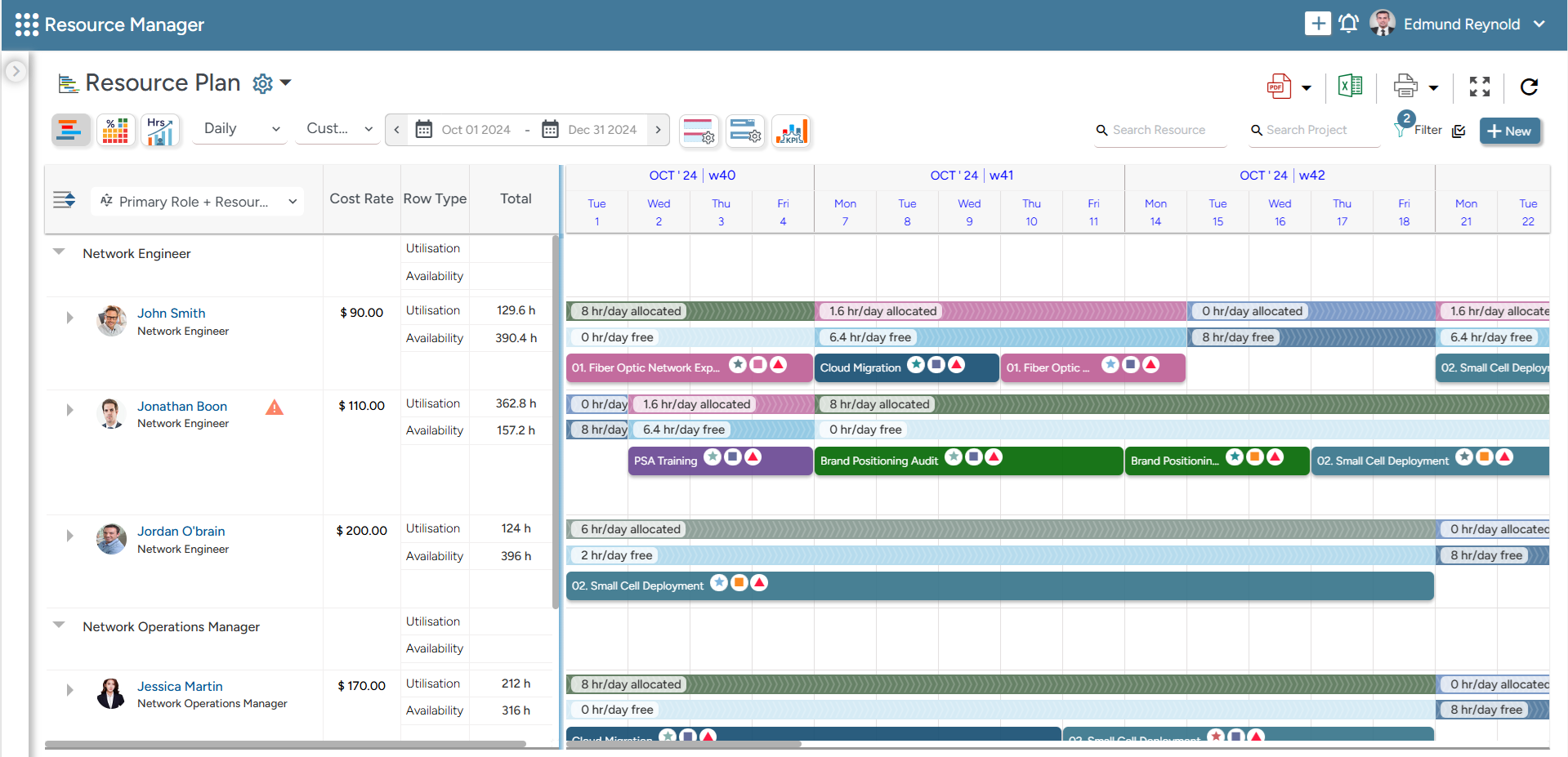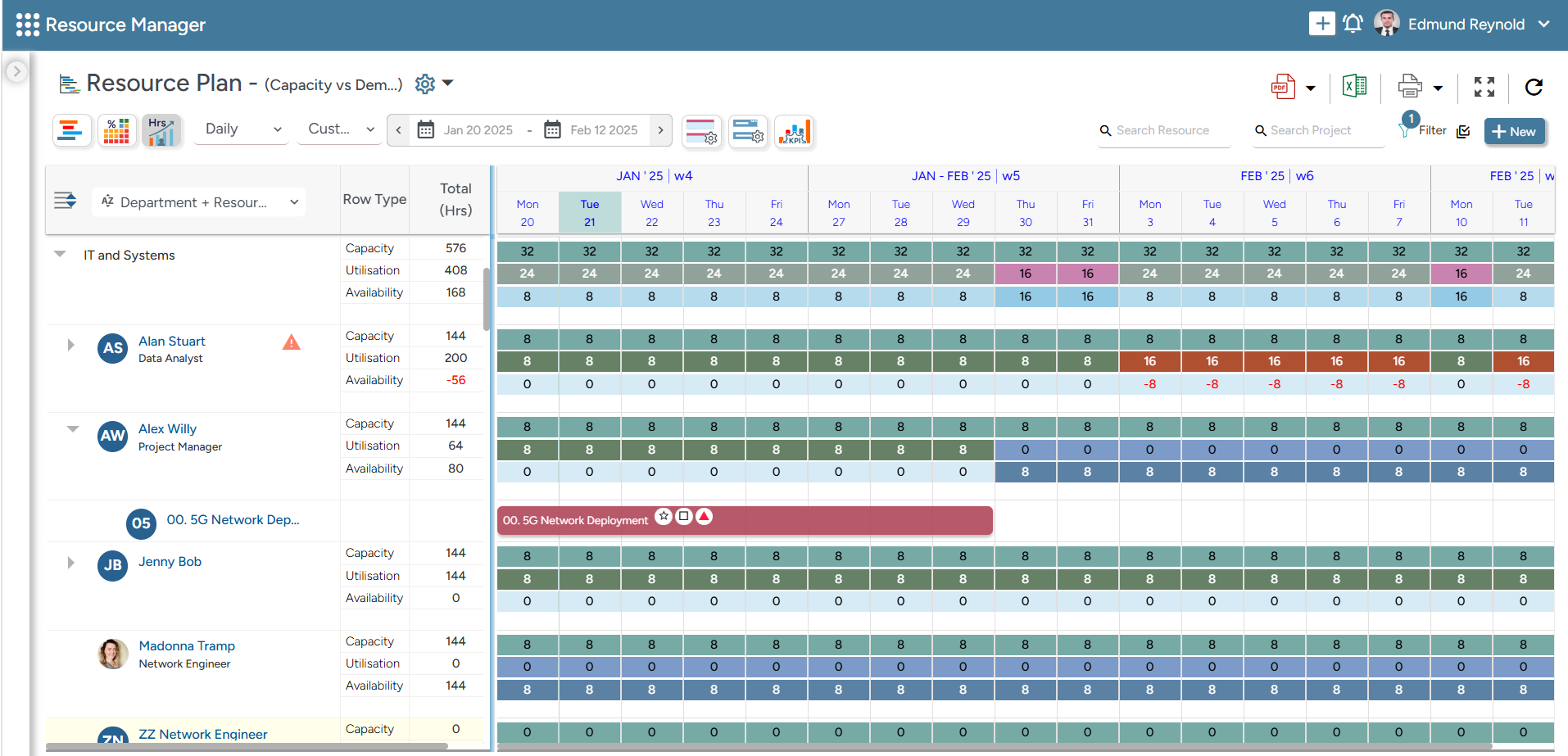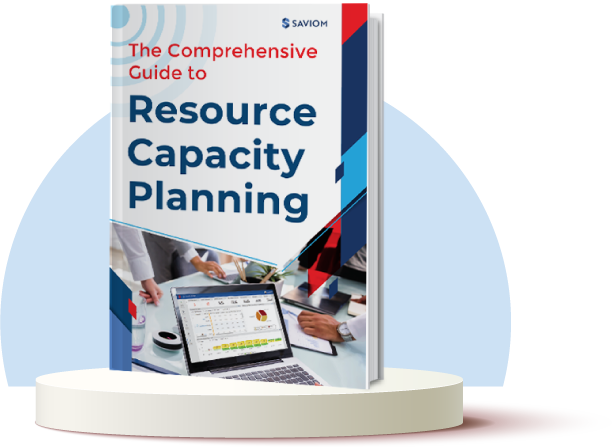In today’s globalized business landscape, organizations operate with a dispersed workforce spread across multiple locations, departments, teams, and projects. While this enables access to diverse skill sets, it also presents a significant challenge – how do you manage resources without real-time visibility?
Without a clear insight into who is available, where they are located, and what expertise they possess, ensuring accurate resource planning is challenging.
This is where a robust resource chart comes into the picture. It provides managers comprehensive visibility into resources-centric attributes across the enterprise, ensuring the right people are identified and deployed to suitable opportunities. Consequently, this helps reduce resourcing costs, fulfill project commitments, and boost profit margins.
In this article, we will explore what a resource chart is and the key steps to creating an effective one.
Let’s dive in.
What is a Resource Chart?
A resource chart, also known as a Gantt chart, is a visual dashboard that offers real-time insights into resource’s capacity, availability, schedules, and utilization across multiple projects. It helps managers effectively plan, foresee, manage, and coordinate resources for seamless project execution and delivery. This enables organizations to reduce operational costs, boost business profitability, and stay ahead of the curve.
Having understood what a resource chart is, let’s explore its prime elements.
Key Components of a Resource Chart
Here’s a rundown of the essential components that must be included in a resource chart:
Project Dates & Timeline
The timeline in a resource chart demonstrates the overall project duration, typically broken down into a daily, weekly, or monthly scale. It highlights when a resource will begin a task, the duration of its deployment, and the project’s expected completion date. This visibility allows managers to allocate employees effectively and prevent resource scheduling conflicts.

SAVIOM’s All-in-One Resource Planner gives complete visibility into project duration as per the chosen scale.
Task Checklist
It outlines all the tasks assigned to each resource, ensuring clarity on individual responsibilities. These tasks are further categorized into manageable sub-tasks, allowing resources to work efficiently and stay on schedule. When managers gain a complete view of what needs to be done, by whom, and when, it helps them keep projects on track.
Resource Availability
The resource chart provides centralized visibility into both human and non-human resources, enabling managers to assess who is available for tasks. Based on this insight, they can determine if the resource is partially or fully available or on leave. This will allow managers to plan work accordingly and deploy them to tasks well before project initiation.
Read More: What is Resource Availability in Project Management, and Why Does It Matter?
Task Dependencies
Project task dependencies provide a visual representation of the relationships between different tasks of a project. It shows which tasks must be completed before others can begin, helping the team complete the work sequentially, i.e., by establishing a clear precedence. Consequently, this prevents task overlaps, ensures seamless workflow, and keeps the project on track.
Resource Schedule
The resource chart offers a comprehensive view of employees’ current and future schedules and typically offers key insights into resource availability, capacity, utilization, roles, and costs. Further, it displays the projects that each resource is allocated to depending on the grouping criteria, such as client, department, team, etc.
Read More: What is Resource Scheduling? How to Schedule Resources for Projects Efficiently?
Now that we are aware of the key elements of the resource chart, let’s explore an example in the next section for a deeper understanding.
Resource Chart Example
A construction project involves multiple phases, such as design, procurement, execution, and inspection, each requiring careful resource planning. A resource chart provides real-time visibility into key factors such as availability, capacity, utilization, etc., enabling managers to make informed decisions swiftly and ensure seamless project execution.
Here’s a representation of what a construction resource chart comprises:
-
Resource Roles & Responsibilities
The resource chart lists all key personnel, such as architects, structural engineers, electricians, plumbers, and laborers, along with their specific task assignments. This enhances clarity regarding tasks and reporting lines, minimizes miscommunication, prevents task duplication, and ensures seamless task execution.
-
Project/Task Assignments & Progress Tracking
Instead of just mapping workers to construction sites, the resource chart outlines specific tasks and sub-tasks assigned within the project (e.g., foundation laying, electrical wiring, or HVAC installation). This helps managers monitor progress, identify resourcing challenges, and take necessary remedial measures as needed.
-
Resource Utilization & Availability
By displaying the utilization levels and availability of each resource, such as., Civil Engineer A (75% allocated, 25% available), Electrician B (60% allocated, 40% available), etc., allows managers to effectively balance workloads. This helps avoid instances of burnout or disengagement and optimizes workforce productivity.
By leveraging a resource chart, the construction company can ensure that the right professionals & equipment are available at the right time, reducing labor costs and leading to on-time project delivery.
Let’s jump to the next section, outlining its rewarding benefits.
Benefits of Using a Resource Chart
A resource chart allows managers to view, plan, and manage resources to ensure competent resource allocation to meet project requirements. Below are a few benefits:
Enhances Task and Resource Visibility
A resource chart offers enterprise-wide visibility into both tasks and resources, including task dependencies, allocations, resource utilization levels, etc. This insight helps managers prevent instances of under or over-allocation and reduce scheduling conflicts to ensure seamless task progression.
Read More: What is Resource Utilization? A Complete Guide to Improve Business Efficiency
Ensures Efficient Resource Planning
A comprehensive resource chart provides a centralized platform for managers to plan, forecast, allocate, and utilize resources effectively and intelligently. With all resource-related data in one place, managers can reduce last-minute firefighting for competent resources, optimize resource utilization, and improve project efficiency.
Enables Real-Time Resource Tracking
A robust resource chart ensures real-time tracking of key workforce attributes like availability, utilization, etc. This visibility helps managers identify and mitigate resource-centric bottlenecks such as resource shortages, sub-optimal resource utilization, instances of double booking, etc., to keep the project on track.
Read More: Overutilization – 10 Effective Strategies to Prevent it for Maximum Efficiency
Facilitates Better Decision-Making
Generally, a resource chart offers a centralized platform that provides role-based access to data. This customized view reduces clutter and enables relevant project stakeholders to focus on key details. These insights empower firms to make informed, data-driven decisions with greater accuracy.
Boosts Team Collaboration
A resource chart provides a centralized view of resource and project-related information, ensuring teams stay aligned toward a common goal. It displays task dependencies, project timelines, resource availability, etc. This eliminates informational silos, enhances knowledge sharing, and fosters collaboration.
Read More: 10 Ways to Improve Cross-Departmental Collaboration
Having understood the key benefits, the following section is dedicated to creating a resource chart step-by-step.
How to Create a Resource Chart?
By leveraging resource charts, managers can effectively streamline resource planning and ensure seamless project delivery. Here’s a step-by-step process for creating a resource chart:
Define Project Scope
Clearly defining the project scope is the key step in determining overall project requirements and serves as a prerequisite for creating the resource chart. Therefore, managers must outline the project’s goals, tasks, deliverables, etc., to establish a well-defined project boundary and facilitate seamless task execution.
For example, in a construction project, outlining the scope ensures that architects, engineers, and contractors are assigned specific tasks based on project phases, like blueprint design, final inspections, etc. This structured approach helps efficiently allocate resources, minimize delays, and ensure smooth project execution.
Read More: What is a Project Scope? Benefits, Best Practices, and Steps to Create an Effective One
Estimate Task Durations
This stage includes determining the duration of each task by including its start and end dates. By accurately estimating how long each task will take, project managers can determine the overall project length and when the final deliverables are expected.
For this, they can assess past project reports or consult with key team members and stakeholders to set realistic time projections. This aids accurate resource planning, prevents last-minute firefighting for competent talent, and ultimately keeps the project on track.
Outline Task Dependencies
The next step is to identify the relationship between tasks and map out dependencies to understand the logical sequence of activities. These tasks can be categorized as Finish-to-Start (FS), Start-to-Start (SS), Finish-to-Finish (FF), and Start-to-Finish (SF) to streamline project workflows.
By visualizing dependencies in a resource chart, managers can effectively prioritize tasks and ensure that delays in one task do not impact the entire project timeline. This allows managers to organize the resource schedule sequentially, prevent conflicts, and facilitate seamless task execution.
Read More: What Project Interdependencies Span Your Portfolio?
Assess Resource Availability
Understanding resource availability is crucial before assigning tasks. Managers must evaluate project resources’ current workloads, their paid time off (PTO), vacation days, and existing commitments to ensure the right resources are available at the right time for suitable tasks/projects.
In case they are not, managers have enough lead time to take necessary resourcing measures to avoid resource-centric bottlenecks like talent shortages, overburdened teams, etc. This will ensure that the project proceeds as intended, within the defined budget and timeline.
Assign Resources to Tasks
Next, managers must evaluate resource skills, expertise, experience, cost, etc., to deploy the right professionals to the right tasks at the right time. This helps avoid over or under-allocation of resources, reduces resourcing costs, and improves workforce productivity.
For example, in a product development project, managers first evaluate resource-centric attributes to identify the best-fit professionals for the task. Accordingly, industrial designers with a strong background in ergonomics are assigned to prototype creation, while quality engineers with compliance expertise handle testing.
Monitor and Adjust Priorities
As the project progresses, a resource chart serves as a dynamic tool to track employee schedules, determine resource shortages, gauge resource utilization levels, etc. Managers can leverage these insights to identify and eliminate resource-centric bottlenecks before they disrupt the project workflow.
For instance, if the resource chart indicates that a contingent resource’s utilization is way below the target, managers can swiftly reallocate them to high-impact, revenue-generating work. This not only enhances employees’ productivity and profitability but also ensures that every resource contributes to the project’s success.
Read More: How to Track Resource Utilization?
Let’s explore the best practices for creating a clear and concise resource chart.
Best Practices for Building an Effective Resource Chart
A resource chart is a powerful resource planning tool. Here are a few best practices that are key to maximizing its effectiveness.
Improve Clarity with Color Coding
Color coding improves the clarity of a resource chart, making it easier for managers to distinguish projects, tasks, priorities, and utilization levels at a glance. For instance, an orange bar can indicate overutilized team members, allowing managers to take timely action to redistribute workloads, thereby streamlining decision-making.
Clearly Define Task and Resource Requirements
It’s important for managers to clearly outline each task and the required resources to avoid confusion. Precisely specifying these details facilitates effective resource planning, ensuring that competent resources are allocated to the tasks. This, in turn, leads to higher workforce efficiency and better project outcomes.
Account for Resource Capacity and Availability
Evaluating each resource’s capacity and availability before allocating tasks is crucial to avoid various workforce-centric bottlenecks such as resource shortages, overburdened teams, etc. This ensures smooth project execution, enhances productivity, and maximizes ROI.
Read More: What is Resource Availability in Project Management, and Why Does It Matter?
Engage Stakeholders Throughout the Project
Creating an accurate resource chart requires active stakeholder involvement from the start. Engaging with them ensures alignment with project goals, secures approvals, and refines resource requirements. This collaborative approach minimizes discrepancies and results in a well-structured resource plan that meets stakeholder and client expectations.
Maintain a Buffer for Unexpected Changes
Managers must maintain a resource buffer to handle unexpected challenges like absenteeism or unplanned attrition without impacting project timelines. By proactively identifying critical roles and securing backup resources, firms can ensure seamless task execution and keep the project on track.
Now, let’s understand the key role of a robust resource management tool in ensuring accurate resource planning.
How Can an Advanced Resource Management Tool Help?
An advanced resource management tool helps plan, forecast, and utilize resources effectively and efficiently to enhance project delivery. Here’s how:
- The tool’s all-in-one resource planner offers multidimensional analysis to help managers gain complete insight into various resource-centric attributes like role, expertise, availability, capacity, etc., enabling dynamic, data-driven decision-making.
- Its embedded capacity planner feature lets managers predict resource shortages and excess ahead of time. Accordingly, firms can take necessary measures to align workforce capacity with future demands.

SAVIOM’s Embedded Capacity Planner helps managers identify & mitigate resource excess or shortages ahead of time.
- The embedded heat mapping feature allows instant visibility into employees’ utilization levels, allowing managers to balance workloads efficiently. This helps them boost productivity and prevent project delays.
- The intelligent matchmaking feature ensures the right project resources are assigned to suitable tasks at the right cost, preventing skill mismatches or scheduling conflicts.
- Beyond these, the tool’s customizable business intelligence reports and dashboards provide real-time analytics, helping managers make data-driven resourcing decisions and ensure smooth project workflow.
Conclusion
A resource chart is a powerful feature that offers a holistic view of all resources, including their availability, schedules, and utilization. It helps optimize resource allocation and maintain optimal utilization levels. Furthermore, when coupled with intuitive resource management software, it empowers managers to make data-driven resource planning decisions and boost workforce productivity.
The Glossary
Read More: Glossary of Resource Workforce Planning, Scheduling and Management











